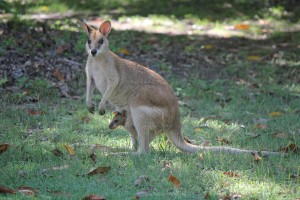The five kilometre long Seaforth Beach provides important habitat for nesting marine turtles. An average of 8.6 flatback turtle nests per year are recorded on Seaforth Beach.
The vulnerable False water rat Essential Habitat covers the mangrove communities lining Seaforth and Victor Creek and extending up to Finlayson Point. The beach scrub ecosystems also provide habitat for the northern quoll, rusty monitor, and coastal sheathtail bat, bandicoots and ring tailed possums.
Seaforth has another little secret, every day wallabies come down to the long sandy beaches at sunrise, and placidly start their day.
Marsupials
There are plenty of Marsupials (Mammals with pouches) to be found around Seaforth. Some, such as the Common Brushtail Possum, Common Ringtail Possum, Northern Brown Bandicoot, Eastern Grey Kangaroos, Agile Wallabies, Whiptail Wallabies, Unadorned Rock-Wallabies, Swamp Wallabies, and Red-Legged Pademelons.
Monotremes
Monotremes are remarkable mammals that lay eggs, have electrosensitive bills (Platypus) or beaks (echidnas), have spurs associated with a venom system, and feed their young on milk. The Echidna is currently the only recorded Monotreme around Seaforth, but we wouldn’t be surprised if some Platypie were found nearby.
Marine
Seaforth boasts a very diverse marine ecosystem. It’s not unusual to see Whales, Snub Fin Dolphins, Sharks or a Turtle on it’s way to shore. The turtles that nest in Seaforth, are mostly Flatback turtles (Natator depressus). Green turtles (Chelonia mydas) occasionally nest in the area and Loggerhead Turtles (Caretta caretta) sometimes nest on offshore islands in the region. All sandy beaches in the Seaforth are considered to be possible turtle nesting sites. The turtle nesting season starts in October and continues through until early to mid January, Turtle eggs hatch until about April.
Reptiles
Seaforth has a diverse range of reptiles including the iconic Salt Water Crocodile and Filled neck Lizard.
Seaforth also has a small and diverse population of snakes. They are rarely seen in the township and prefer to stay in their natural habitat. It is recommended that you avoid agetaing any snakes you many see and just let them go about their business. If they need to be relocated for whatever reason please call – Wildlife Rescue 0447 543 268.
Here is a overly long list of snakes that can be found in the Seaforth.
Bandy Bandy, Keel Back, Curl Snake, Robust Burrowing Snake, Half Girdled Snake, Australian Coral Snake, Black Striped Snake, Eastern Small Eyed Snake, Carpentaria Whip Snake, Eastern Brown Snake, Speckled Brown Snake, Red Bellied Black Snake, Mulga Snake, Coastal Taipan, Carpet Python, Spotted Python, Pale Headed Snake, Marsh Snake, Orange Naped Snake, Red Naped Snake, Yellow Naped Snake, De Vis Banded, Common Tree Snake, Lesser Black Whip Snake, Collared Whip Snake, Yellow Faced Whip Snake, Golden Crowned Snake, White Crowned Snake, Brown Tree Snake and the Black Headed Python.
